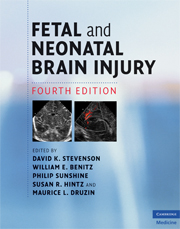Book contents
- Frontmatter
- Contents
- List of contributors
- Foreword
- Preface
- Section 1 Epidemiology, pathophysiology, and pathogenesis of fetal and neonatal brain injury
- Section 2 Pregnancy, labor, and delivery complications causing brain injury
- Section 3 Diagnosis of the infant with brain injury
- Section 4 Specific conditions associated with fetal and neonatal brain injury
- Section 5 Management of the depressed or neurologically dysfunctional neonate
- Section 6 Assessing outcome of the brain-injured infant
- 45 Early childhood neurodevelopmental outcome of preterm infants
- 46 Cerebral palsy: advances in definition, classification, management, and outcome
- 47 Long-term impact of neonatal events on speech, language development, and academic achievement
- 48 Neurocognitive outcomes of term infants with perinatal asphyxia
- 49 Appropriateness of intensive care application
- 50 Medicolegal issues in perinatal brain injury
- Index
- Plate section
- References
45 - Early childhood neurodevelopmental outcome of preterm infants
from Section 6 - Assessing outcome of the brain-injured infant
Published online by Cambridge University Press: 12 January 2010
- Frontmatter
- Contents
- List of contributors
- Foreword
- Preface
- Section 1 Epidemiology, pathophysiology, and pathogenesis of fetal and neonatal brain injury
- Section 2 Pregnancy, labor, and delivery complications causing brain injury
- Section 3 Diagnosis of the infant with brain injury
- Section 4 Specific conditions associated with fetal and neonatal brain injury
- Section 5 Management of the depressed or neurologically dysfunctional neonate
- Section 6 Assessing outcome of the brain-injured infant
- 45 Early childhood neurodevelopmental outcome of preterm infants
- 46 Cerebral palsy: advances in definition, classification, management, and outcome
- 47 Long-term impact of neonatal events on speech, language development, and academic achievement
- 48 Neurocognitive outcomes of term infants with perinatal asphyxia
- 49 Appropriateness of intensive care application
- 50 Medicolegal issues in perinatal brain injury
- Index
- Plate section
- References
Summary
Epidemiology of preterm birth: framing the issues of sequelae
Preterm birth is a substantial and growing problem for developed nations. In the United States between 1990 and 2004, the proportion of live-born infants delivered preterm (< 37 weeks estimated gestational age, EGA) rose from 10.6% to 12.5%; the proportion delivered very preterm (< 32 weeks EGA) rose from 1.92% to 2.01%. Thus, more than 500,000 preterm infants and 82,000 very preterm infants were born in the United States alone in 2004. With improvements in perinatal and neonatal care and technology over the past decades, survival of preterm infants has improved significantly, particularly among the smallest and most immature subgroups. In the Netherlands, survival to discharge for infants of 22–27 weeks EGA rose from 36.1% to 67.8% between 1983 and 1995. In two large regional tertiary care centers in Sweden, survival to discharge for live-born infants of 23–25 weeks EGA increased from 55% to 78% from 1992 to 1998. In the state of Victoria, Australia, survival to discharge among infants of 23–27 weeks EGA increased from 56% in 1991–92 to 72% in 1997; of note in the 1997 birth cohort, survival was 41%, 41%, and 73% for 23-, 24-, and 25-week EGA groups, respectively. For extremely low-birthweight (ELBW) infants overall in Victoria, survival rate increased from 38% in 1985–87, to 56% in 1991–92, to 73% in 1997.
- Type
- Chapter
- Information
- Fetal and Neonatal Brain Injury , pp. 544 - 555Publisher: Cambridge University PressPrint publication year: 2009



